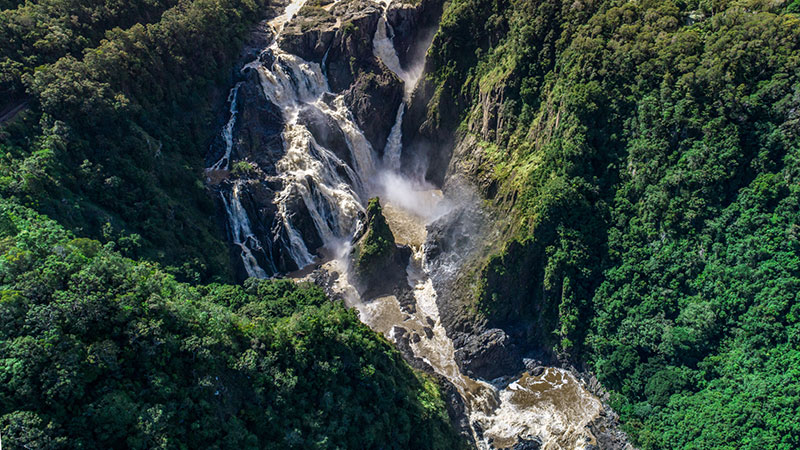Cairns weather | Living tropical
Today in Cairns, the weather is...
Cairns climate
Most people considering a move to Cairns have questions about Cairns weather.
They want to know how hot it is in Cairns in the summer, what the humidity is like, and how often we get cyclones.
The temperature remains pretty steady in Cairns throughout the year. If you look at the Cairns weather report for June, you will find the maximum daytime temperature is similar whether it is the height of summer or the middle of winter in Cairns. There is a big difference, however, in the humidity and in the minimum temperature.
Winter in Cairns means low humidity and, occasionally, minimum temperatures in the single digits. It is about this point that Cairns people reach for their only jumper. For those craving cooler weather, the surrounding Tablelands less than an hour away, can dip below three or four degrees in winter.
Summer weather in Cairns can be sticky and steamy, with humidity particularly high through December and January.
The Bureau of Meteorology (BOM) shows typical daytime temperatures in Cairns range from:
- 23°C min -31°C max average in mid-Summer
- 18°C min -26°C max average in mid-Winter
Living with tropical weather in Cairns
Locals boast about the the Autumn and Winter days in Cairns. Cairns weather is close to perfect between May and August. The sun shines; the air has a cool edge and the skies are clear. Cairns in June is often described as 'magical'.
Most people moving to Cairns, however, really want to know what it's it like to live with tropical Summer weather conditions like humidity, wet season rains and cyclones.
Average annual maximum temperatures for Cairns are 29°C with 62 per cent humidity. On paper, this looks pretty good but the increase in humidity during Summer definitely changes the 'feels like' temperature.
Air conditioning can be your best friend in December and January. Just like heating is a must in Australia's cooler states, air conditioners are important in Cairns! Solar power is an obvious and popular choice in Far North Queensland. It allows us to take advantage of, and mitigate the effects of, our plentiful sunshine.
Does Cairns have many cyclones?
Perhaps the second biggest weather worry for people considering a move to Cairns is cyclones. In Cairns, we do live with a risk of experiencing a cyclone but we rarely see the sort of big, sudden damaging storms that can hit the southern states.
The tropical cyclone season is - officially - 1 November - 30 April. Cyclones generally form off the east coast of Australia several times a year. If a cyclone forms or grows near Cairns, it might bring rain and strong winds, sometimes lasting for several days. A cyclone watch is declared when a low pressure system forms.
Prepared Cairns people make sure they have a cyclone kit ready to go by November. A cyclone kit is much like a bush camping kit. It contains everything a household would need to live without power or running water for three days.
Local people in Cairns can count on one hand the number of times a cyclone or tropical low has caused damage to homes, the environment or affected power or water supply in Cairns in the past 20 years. But they do happen. And, sometimes, a cyclone will cross the coast.
The Cairns community is prepared and resilient.
Because cyclones are a weather event that affect our community from time to time, we have the information, resources, experience and contingencies to 'weather' a disaster. Being prepared, having a plan and packing an emergency kit in summer is a part of living in our north tropical climate.
Wet season in Cairns
The 'wet season' makes our gardens grow - a lot. In Cairns, our highest rainfall is generally in January and February, with December and March also dropping more rain than average in the region.
- 1960mm average annual rainfall in Cairns (over the past 30 years)
- 44 days a year with more than 10mm of rainfall a day (annual average)
- 118 days a year with rain of 1mm or more (annual average)
A few weeks a year, we will usually get the sort of sustained downpours that turn the school oval into a lake, complete with ducks, or transform the Barron Falls into a truly spectacular natural phenomenon. We don't often see storms with thunder or lightning in Cairns. Cairns rains are steady, strong and, during the wet season, can continue non-stop for several days.

Cairns humidity
For around three weeks of the year the humidity can be intense and challenging in Cairns. This usually happens around January/ December.
Just as cooler climates are set up with heating for winter; Cairns homes and businesses have air conditioning and fans for cooling in summer. And we use them. Truth is, most Cairns people put their air conditioners to work in summer, particularly at night.
The humidity can make your glasses fog up when you leave your air conditioned car. But it's also something that is a unique and defining part of living in a tropical city. Stepping off a plane at Cairns Airport on a summer's day is a very special kind of welcoming 'homecoming' for many locals.
The Queenslander is a popular housing option in Cairns, and so are verahdahs and features that maximise breezes and keep us cool. We also have some very nice, natural cooling options - freshwater creeks, waterfalls and shady rainforest tracks.
You can find out more about tropical building features from Cairns Regional Council.

